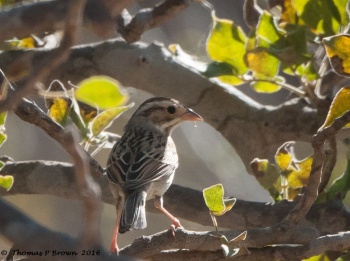- Passerculus sandwichensis
Includes: Large-billed Sparrow
Identification

Photo © by Thomas P Brown
Sierra La Laguna, Mexico, 9 April 2016
11·4–15·4 cm (4½-6 inches)
- Conical bill
- Short, forked tail
- Yellow to white supercilium
- Thin, white central crown stripe
- Dark brown to grey-brown upperparts with dark streaks
- White underparts with dark streaks
- Sexes similar
Distribution
North America. Summers from the lower-middle latitudes of the U.S. through the lower provinces of Canada. Resident populations in Mexico and Guatemala. Migrates to the southern states and Mexico in winter. Missing along the west coast.
Taxonomy
Subspecies
Polytypic, more than 20 subspecies recognized[1]:
- P. s. oblitus: Central Canada and north-central US; winters to north-eastern Mexico
- P. s. mediogriseus: South-eastern Canada (Ontario to Gaspé Peninsula) and north-eastern US; winters to south-eastern US
- P. s. labradorius: Eastern Quebec, Labrador and Newfoundland; winters to south-eastern Texas
- P. s. savanna: Nova Scotia, Prince Edward Island and Magdalen Island; winters to Bahamas
- P. s. princeps: Sable Island (Nova Scotia); winters to coastal Massachusetts to Georgia
- P. s. anthinus: Aleutian Islands and northern Alaska to south-westerm Canada; winters to Baja, southern Mexico
- P. s. sandwichensis: Amutka Island, eastern Aleutians and western Alaskan Peninsula; winters to southern California
- P. s. crassus: South-Eastern Alaska (Alexander Archaepelago) and adjacent mainland Alaska
- P. s. brooksi: Vancouver Island and coastal south-western British Columbia to north-western California; winters to Baja
- P. s. alaudinus: Coastal northern California (Humboldt to San Luis Obispo County)
- P. s. nevadensis: Great Basin and Great Plains of North America; winters to southern Mexico
- P. s. rufofuscus: Central Arizona and northern New Mexico to northern Mexico (Chihuahua)
- P. s. brunnescens: Mexico (Durango to Jalisco, Puebla, Guerrero and Oaxaca)
- P. s. wetmorei : Mountains of extreme south-western Guatemala
- P. s. beldingi: Coastal southern California (Santa Barbara County) to northern Baja California
- P. s. anulus: Bahía Vizcaino area of Baja California
- P. s. guttatus: Coastal western Baja California (Laguna San Ignacio region)
- P. s. magdalenae: Coastal western Baja California (Bahia Magdalena region)
- P. s. sanctorum: San Benito Islands (off western Baja California)
- P. s. rostratus: North-eastern Baja California (mouth of Colorado River and adjacent Sonora)
- P. s. atratus: Coastal north-western Mexico (central Sonora to central Sinaloa)
Rostratus and atratus from Mexico are sometimes split as Large-billed Sparrow, Passerculus rostratus.
P. s. sanctorum from San Benito Island is called San Benito Sparrow, a group of four races around the Baja California are known as Belding's Sparrow.
Habitat
Open fields with fairly short vegetation and grasslands.
Behaviour
Diet
Forages on the ground. The diet consists mainly of seeds, but larva, pupae, adult insects and other invertebrates are also eaten in the breeding season.
Breeding
They nest on the ground, laying 3-6 eggs in a cup nest sheltered by a clump of grass or other vegetation. There are usually two broods, but sometimes three or more.
Vocalisations
Typical song in breeding season a lisping, buzzy “tzip-tzip-tzip streeeeeee-ip”
References
- Clements, J. F., T. S. Schulenberg, M. J. Iliff, D. Roberson, T. A. Fredericks, B. L. Sullivan, and C. L. Wood. 2018. The eBird/Clements checklist of birds of the world: v2018. Downloaded from http://www.birds.cornell.edu/clementschecklist/download/
- Rising, J. (2018). Large-billed Sparrow (Passerculus rostratus). In: del Hoyo, J., Elliott, A., Sargatal, J., Christie, D.A. & de Juana, E. (eds.). Handbook of the Birds of the World Alive. Lynx Edicions, Barcelona. (retrieved from https://www.hbw.com/node/61920 on 15 October 2018).
- Wheelwright, N. T. and J. D. Rising (2008). Savannah Sparrow (Passerculus sandwichensis), version 2.0. In The Birds of North America (A. F. Poole, Editor). Cornell Lab of Ornithology, Ithaca, NY, USA. https://doi.org/10.2173/bna.45
- Zink, Robert M., James D. Rising, Steve Mockford, Andrew G. Horn, Jonathan M. Wright, Marty Leonard and M. C. Westberg. 2005. Mitochondrial DNA variation, species limits, and rapid evolution of plumage coloration and size in the Savannah Sparrow. Condor no. 107 (1):21-28.
- Project Noah
Recommended Citation
- BirdForum Opus contributors. (2024) Savannah Sparrow. In: BirdForum, the forum for wild birds and birding. Retrieved 26 April 2024 from https://www.birdforum.net/opus/Savannah_Sparrow
External Links
GSearch checked for 2020 platform.





